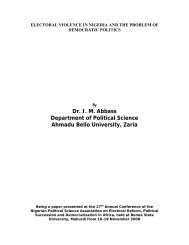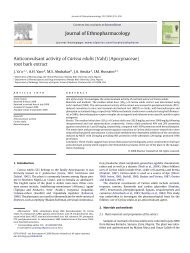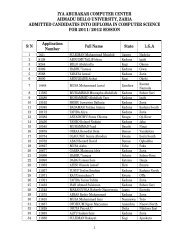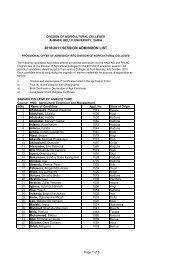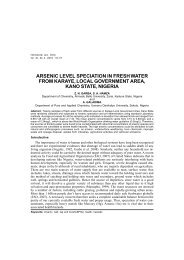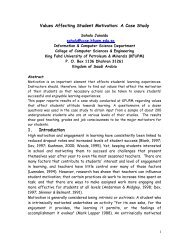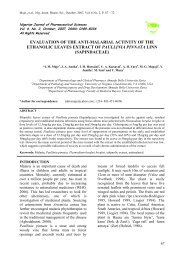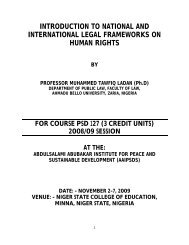Phytochemical screening and antibacterial activities of Vernonia ...
Phytochemical screening and antibacterial activities of Vernonia ...
Phytochemical screening and antibacterial activities of Vernonia ...
You also want an ePaper? Increase the reach of your titles
YUMPU automatically turns print PDFs into web optimized ePapers that Google loves.
<strong>Phytochemical</strong> <strong>screening</strong> <strong>and</strong> <strong>antibacterial</strong> <strong>activities</strong> <strong>of</strong> Veronia ambigua... 69Test for free anthraquinones (Bontragerís test)Small portion <strong>of</strong> the extract was shaken with10 mL <strong>of</strong> benzene <strong>and</strong> filtered. Five milliliters <strong>of</strong>10% NH 3 solution was added to the filtrate <strong>and</strong>stirred. The production <strong>of</strong> a pink-red or violet colorindicates the presence <strong>of</strong> free anthraquinones.Test for saponins (Frothing test)Small quantity <strong>of</strong> the extract was dissolved in10 mL <strong>of</strong> distilled water. This was then shaken vigorouslyfor 30 s <strong>and</strong> was allowed to st<strong>and</strong> for 30min. A honey comb formed for more than 30 minindicates saponins.Test for steroids <strong>and</strong> triterpenes (Lieberman-Burchardís test)Equal volume <strong>of</strong> acetic anhydride was added tothe extract. One milliliter <strong>of</strong> conc. H 2 SO 4 was addeddownside the tube <strong>and</strong> the color change wasobserved immediately <strong>and</strong> later. Red, pink or purplecolor indicates the presence <strong>of</strong> triterpenes while blueor blue-green indicates steroids.Test for flavonoids (Shinoda test)About 0.5 g <strong>of</strong> the extract was dissolved in 1.5mL <strong>of</strong> 50% methanol <strong>and</strong> warmed on steam bath.Metallic magnesium <strong>and</strong> 5 drops <strong>of</strong> concentratedhydrochloric acid were added. A red or orange colorindicates the presence <strong>of</strong> flavonoids aglycone.Test for tannins (Ferric chloride test)About 0.5 mL <strong>of</strong> extract was dissolved in 10mL <strong>of</strong> distilled water <strong>and</strong> then filtered. Few drops <strong>of</strong>ferric chloride solution were added to the filtrate.Formation <strong>of</strong> a blue-black precipitate indicateshydrolyzable tannins <strong>and</strong> green precipitate indicatesthe presence <strong>of</strong> condensed tannins.Test for alkaloids (Dragend<strong>of</strong>fís test)To about 0.5 g <strong>of</strong> each extract, 1% diluted HCl(20 mL) was added in a conical flask, heated on asteam bath <strong>and</strong> then filtered. The filtrate was madealkaline with 28% NH 3 solution <strong>and</strong> then extractedwith chlor<strong>of</strong>orm (3 ◊ 5 cm 3 ). The combined CHCl 3extracts were concentrated <strong>and</strong> treated with equalvolume <strong>of</strong> 1% HCl. Dragendorffís reagents (2 mL)were added <strong>and</strong> occurence <strong>of</strong> orange-red precipitateindicated the presence <strong>of</strong> alkaloids.Test organismsTen clinical bacterial strains: Klebsiella pneumoniae,Streptococcus pyogenes, Staphylococcusaureus, Corynbacterium ulcerans, methicillin resistantStaphylococcus aureus (MRSA), Salmonellatyphi, Pseudomonas aeruginosa, Shigella dysentriae,Proteus mirabilis <strong>and</strong> Pseudomonas fluorescencewere obtained from the Department <strong>of</strong>Microbiology, Ahmadu Bello University TeachingHospital (ABUTH) Shika. The isolates were purifiedon nutrient agar (OXOID) plates <strong>and</strong> characterizedusing st<strong>and</strong>ard microbiological <strong>and</strong> biochemicalprocedures (26, 27). The MRSA strains used inthis study were clinical isolates from urethral swab,seminal fluid, urine, high virginal swab, blood, skin<strong>and</strong> sputum <strong>of</strong> patients with symptoms <strong>of</strong> S. aureusassociateddiseases. The isolates were identified byst<strong>and</strong>ard method (26). The disc diffusion methodoutlined by the NCCLS (28) was used with 1 µgoxacillin disk (Oxoid). The zones <strong>of</strong> inhibition weremeasured after incubation at 35 O C for 24 h. Isolateswith zones diameter = 10 mm were consideredmethicillin resistant. The organisms were maintainedon agar slope at 4 O C <strong>and</strong> subcultured for 24 hbefore use.Determination <strong>of</strong> <strong>antibacterial</strong> activityThe disc diffusion method was used (29).Stock solution (100 mg/mL) <strong>of</strong> each extract <strong>and</strong>fractions were prepared using the extractants. Discs(6 mm diameter) were prepared using Whatman filterpaper <strong>and</strong> sterilized by autoclaving. The blanksterile discs were placed on the inoculated MuellerHinton Agar (MHA) surface <strong>and</strong> impregnated with15 µL <strong>of</strong> stock solutions (1500 µg/dics). Antibioticdiscs <strong>of</strong> ampiclox (75 µg/dics) <strong>and</strong> streptomycin (30µg/dics) were used as positive control, whereas discs<strong>of</strong> the extracting solvents were used as negative control.The plates were incubated at 37 O C for 24 h. Alltests were performed in triplicate <strong>and</strong> the <strong>antibacterial</strong><strong>activities</strong> were expressed as the mean diameter <strong>of</strong>inhibition zones (mm) produced by the plantextracts.Minimum inhibitory concentration (MIC)The minimum inhibitory concentration (MIC)was determined using micro-broth dilution methodsas outlined by NCCLS (30). Dilutions (1ñ9mg/mL) <strong>of</strong> concentrations <strong>of</strong> extract <strong>and</strong> fractionsthat exhibited sensitivity against the test organismswere prepared using test tubes containing 9 mL <strong>of</strong>double strength broth. The test tubes were inoculatedwith the suspension <strong>of</strong> the st<strong>and</strong>ardized inocula.These were incubated at 37 O C for 24 h <strong>and</strong>observed for growth. The minimum inhibitory concentrations(MICs) <strong>of</strong> the extracts/fractions foreach test organism were regarded as the lowestconcentration that inhibited visible growth <strong>of</strong> thetest organisms.


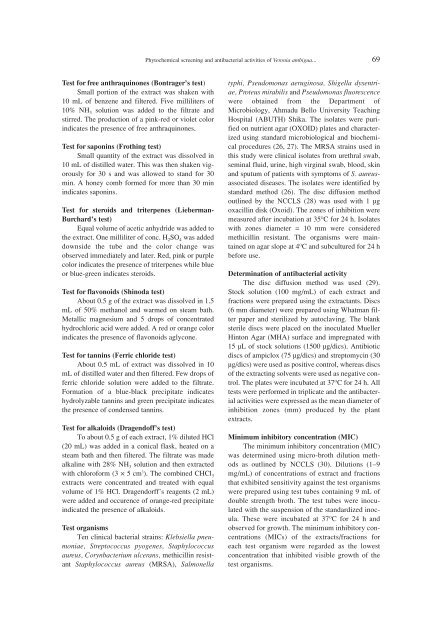
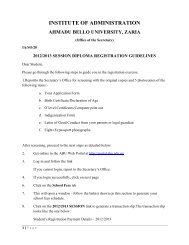
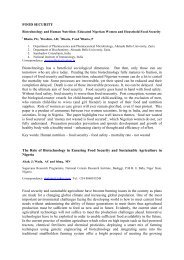

![Full Paper [PDF]](https://img.yumpu.com/49740055/1/184x260/full-paper-pdf.jpg?quality=85)
